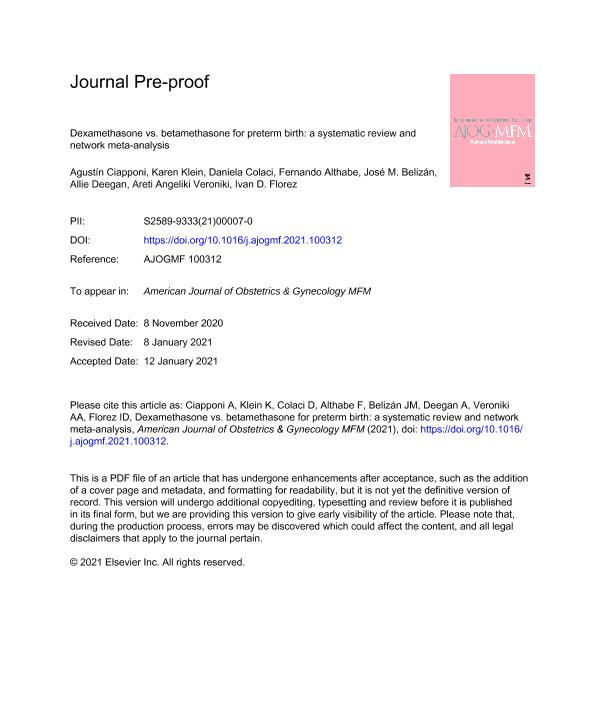Artículo
Dexamethasone versus betamethasone for preterm birth: a systematic review and network meta-analysis
Ciapponi, Agustín ; Klein, Karen; Colaci, Daniela; Althabe, Fernando
; Klein, Karen; Colaci, Daniela; Althabe, Fernando ; Belizan, Jose
; Belizan, Jose ; Deegan, Allie; Veroniki, Areti Angeliki; Florez, Ivan D.
; Deegan, Allie; Veroniki, Areti Angeliki; Florez, Ivan D.
 ; Klein, Karen; Colaci, Daniela; Althabe, Fernando
; Klein, Karen; Colaci, Daniela; Althabe, Fernando ; Belizan, Jose
; Belizan, Jose ; Deegan, Allie; Veroniki, Areti Angeliki; Florez, Ivan D.
; Deegan, Allie; Veroniki, Areti Angeliki; Florez, Ivan D.
Fecha de publicación:
05/2021
Editorial:
Elsevier
Revista:
American Journal of Obstetrics and Gynecology MFM
ISSN:
2589-9333
Idioma:
Inglés
Tipo de recurso:
Artículo publicado
Clasificación temática:
Resumen
Objective: This study aimed to evaluate the comparative clinical effectiveness and safety of dexamethasone vs betamethasone for preterm birth. Data Sources: The sources searched were MEDLINE, EMBASE, Cochrane Library, LILACS, ClinicalTrials.gov, and International Clinical Trials Registry Platform without language restrictions until October 2019 in addition to the reference lists of included studies. Field experts were also contacted. Study Eligibility Criteria: Randomized or quasi-randomized controlled trials comparing any corticosteroids against each other or against placebo at any dose for preterm birth were included in the study. Methods: Three researchers independently selected and extracted data and assessed the risk of bias of the included studies by using Early Review Organizing Software and Covidence software. Random-effects pairwise meta-analysis and Bayesian network meta-analysis were performed. The primary outcomes were chorioamnionitis, endometritis or puerperal sepsis, neonatal death, respiratory distress syndrome, and neurodevelopmental disability. Results: A total of 45 trials (11,227 women and 11,878 infants) were included in the study. No clinical or statistical difference was found between dexamethasone and betamethasone in neonatal death (odds ratio, 1.05; 95% confidence interval, 0.62–1.84; moderate-certainty evidence), neurodevelopmental disability (odds ratio, 1.03; 95% confidence interval, 0.80–1.33; moderate-certainty evidence), intraventricular hemorrhage (odds ratio, 1.04; 95% confidence interval, 0.56–1.78); low-certainty evidence), or birthweight (+5.29 g; 95% confidence interval, −49.79 to 58.97; high-certainty evidence). There was no statistically significant difference, but a potentially clinically important effect was found between dexamethasone and betamethasone in chorioamnionitis (odds ratio, 0.70; 95% confidence interval, 0.45–1.06; moderate-certainty evidence), fetal death (odds ratio, 0.81; 95% confidence interval, 0.24–2.41; low-certainty evidence), puerperal sepsis (odds ratio, 2.04; 95% confidence interval, 0.72–6.06; low-certainty evidence), and respiratory distress syndrome (odds ratio, 1.34; 95% confidence interval, 0.96–2.11; moderate-certainty evidence). Meta-regression, subgroup, and sensitivity analyses did not reveal important changes regarding the main analysis. Conclusion: Corticosteroids have proven effective for most neonatal and child-relevant outcomes compared with placebo or no treatment for women at risk of preterm birth. No important difference was found on neonatal death, neurodevelopmental disability, intraventricular hemorrhage, and birthweight between corticosteroids, and there was no statistically significant difference, but a potentially important difference was found in chorioamnionitis, fetal death, endometritis or puerperal sepsis, and respiratory distress syndrome. Further research is warranted to improve the certainty of evidence and inform health policies.
Archivos asociados
Licencia
Identificadores
Colecciones
Articulos(CIESP)
Articulos de CENTRO DE INVESTIGACIONES EN EPIDEMIOLOGIA Y SALUD PUBLICA
Articulos de CENTRO DE INVESTIGACIONES EN EPIDEMIOLOGIA Y SALUD PUBLICA
Citación
Ciapponi, Agustín; Klein, Karen; Colaci, Daniela; Althabe, Fernando; Belizan, Jose; et al.; Dexamethasone versus betamethasone for preterm birth: a systematic review and network meta-analysis; Elsevier; American Journal of Obstetrics and Gynecology MFM; 3; 3; 5-2021; 1-38
Compartir
Altmétricas



